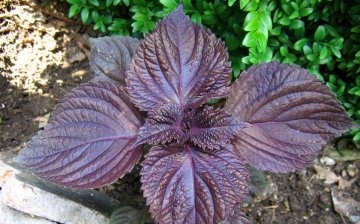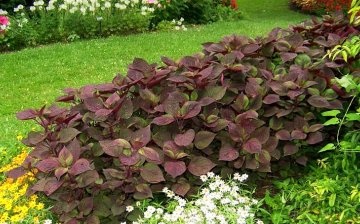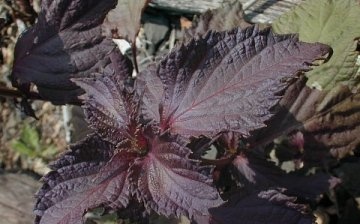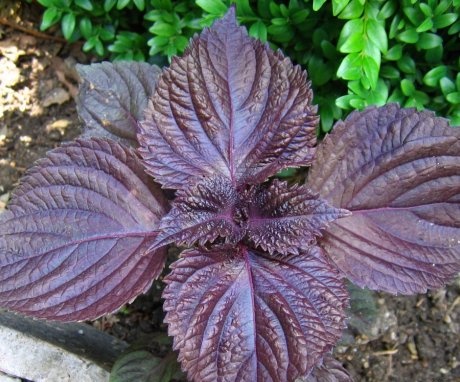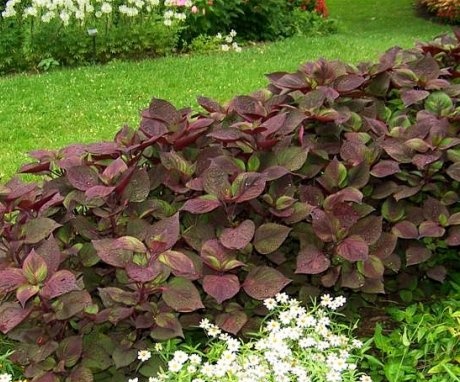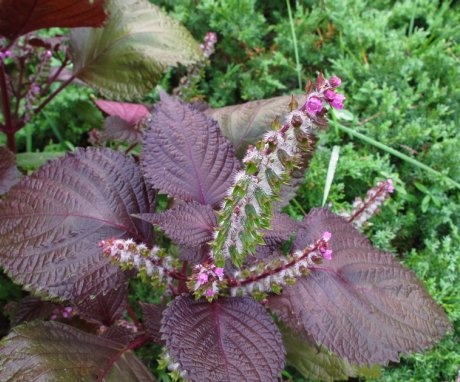Perilla shrub - a beautiful plant with useful properties
Perilla shrub is an annual plant that is related to mint and basil... The birthplace of perilla is Japan, where it is in great demand in cooking. The plant reaches a height of one and a half meters and has serrated leaves with a purple, green or variegated color. The purple perilla bears great resemblance to basil.
Perilla flowers are usually white, bell-shaped. As the flowers ripen, grains-seeds are formed in place of the flowers, which are very valuable in the production of varnish-and-paint coatings. Not only that, the seed oil has health benefits when consumed. The plant itself contains a rich content of carotene, and the pigment has an analgesic and anti-inflammatory effect. Perilla is also often used for landscape design on city streets, as it perfectly dilutes the compositions of flower beds and flower beds.
Content:
Reproduction and planting
Our climate is suitable for growing perilla... Most often it is used for landscape design. The plant is grown using seedlings. Planting a perilla using seeds takes a long time, since they take a long time to sprout.
Perilla seeds are planted from late April to early May.
Features of plant propagation using seeds:
- To accelerate and germinate seeds, you should soak them for three days, while changing the water at least 2-3 times a day. It is important that the seeds are fresh, since 2-3 years of storage will reduce germination to zero.
- Next, the seeds are planted in a container to a depth of 5 mm. Soil for planting: 2 parts of humus and 1 part of peat, if desired, you can use mineral fertilizers... It is also important to put drainage on the bottom of the container, for example, expanded clay.
- Seeds are planted densely enough to remove weak shoots during growth. The soil is moistened, and the containers are covered with foil.
Seedlings should appear in 8-10 days. After two leaves appear on the shoot, it can be planted in the ground. A suitable period for this is the beginning of June. It is important that frost-free conditions are guaranteed. The optimum temperature for perilla growth is from 22 to 28 degrees.
The distance between the shoots should be from 20 to 30 cm.The perilla is collected at the beginning flowering... The stems are cut, leaving a 10 centimeter stalk. Perilla can be cut twice per season.
Plant care tips
Perilla is quite unpretentious to care for, but you should remember some rules that will help you grow healthy and strong plants.
- It is worth planting the railing in a bright and draft-free place.
- The soil should be loosened and weeded, it should absorb moisture well.
- The soil should be predominantly black earth. The plant will not be able to grow in swampy or sandy areas.
- In the case of excessively rapid growth up to 1 meter, you can do the pinching of the shoots.
- With excessive soil moisture and low temperatures, flowering and pollination occurs much later.
- Perilla can be fed with potassium salt and saltpeter, as well as nettle infusion.
When choosing seeds, you should pay attention to the name of the species. The absence of the name of the type of perilla on the label may indicate poor quality raw materials.
You can get the seeds yourself. For this, several of the strongest plants are transplanted into pots, and they are grown on the windowsill in the autumn. Perilla will bloom in winter, and by summer it will be possible to get seeds for sowing.
Pest and disease control
The main pests that will have to be dealt with when growing perilla:
- Sandy slow. This beetle contributes to seed damage at the time of germination. After the sprout appears, the slug gnaws at the stem. To combat this pest, there are the following methods: deep plowing of the soil, timely destruction weeds and fallen leaves, the use of alkaline and lime fertilizers, as well as special poisonous baits.
- Cotton scoop. The caterpillar or butterfly of this pest damages both seeds and leaves with stems. For prophylactic control of the scoop, you should: often loosen the soil around the plant, thus destroying caterpillars, destroy weeds in time, since scoops like to lay eggs on them, collect pests by hand, spray perilla with a decoction of burdock, pepper or wormwood, use baits with fermented kvass, and in neglected cases, insecticides are used to control scoop.
- Spider mite. These small insects, up to 1 mm in size, braid the leaves of the plant with a cobweb. They hide on the underside of the foliage, as well as in the ground. Tick colonies can number hundreds of insects. Ticks feed on plant sap, nibbling the leaves, which subsequently dry up and fall off. The first signs of tick damage are manifested in the appearance of white spots and cobwebs on the leaves of the perilla. The plant becomes less resistant to infections and diseases. Preventively, it is advisable to spray the plants with water, since the mite does not like moisture. You should also periodically collect fallen leaves and remove dried plants. If the spider mite has just settled on the plant, then, first of all, it is necessary to thoroughly rinse the perilla with an aqueous solution with the addition of laundry soap. To begin with, you can try to do without chemicals and treat the perilla with water with the addition of Neem tree oil, and then put bags on the affected plants and leave for three days. If the spider mite has affected most of the crop, then only special insecticides will help.
Perilla diseases:
- In addition to pests, perilla is prone to diseases such as leaf spot. It can be observed before the flowering of the plant. The edges of the leaves begin to dry out, acquiring a brown color. Such plants usually grow poorly and reduce yields. Plantings should be carefully monitored and diseased plants should be immediately destroyed to avoid spread. Since it is a fungal disease, the soil also requires processing after harvest. The infected soil should be sprayed with Bordeaux liquid several times.
- Another disease that can affect perilla is gray rot. The reason may be too frequent planting and excessive moisture. At the initial stage, the leaves are covered with gray spots, which then develop into mold, capturing the entire plant. If gray rot has just formed on the perilla, then you can try to spray the plant with iodine solution. Also, the affected leaves should be treated. ash... As a last resort, they will come to the rescue fungicides.
The use of perilla shrub
Perilla has long been used in food preparation. It is especially in demand in Japanese cuisine. You can use it both fresh and as a seasoning. Perilla has a lemon-anise flavor, which adds a special piquancy to the dishes.
Perilla leaves are often used in marinades and even when preparing compotes. They color the liquid in a pleasant pink color. Perilla is also good in meat dishes, but it is worth adding it a few minutes before cooking, so the aroma is better preserved.
In addition, perilla has a huge number of useful properties:
- Perilla essential oil is rich in alpha-linoleic and omega-3 acids.
- Consuming oil will help get rid of high cholesterol, joint inflammation and skin diseases, as well as calm the nervous system.
- The presence of tannins has antiseptic, anti-inflammatory and expectorant effects.
For colds, you can prepare an infusion. 4 tablespoons of dried perilla stems and leaves are poured into 500 ml of water and boiled in a water bath for 15 minutes. Next, the broth must be infused for 1.5 hours and filtered. Take half a glass up to five times a day.
Dried perilla greens are sold in powder form as a fortifying supplement.
Contraindication to use is pregnancy and lactation. Perilla is often used in the manufacture of various cosmetics: creams, masks and even shampoos.
Despite its wonderful properties, perilla is not very popular among Russian flower growers and gardeners. However, many believe that due to its taste, perilla is able to compete with our favorite spices - dill, parsley and basilica... After trying this spice once, you will want to feel its piquant and refreshing aroma again and again.
More information can be found in the video:




